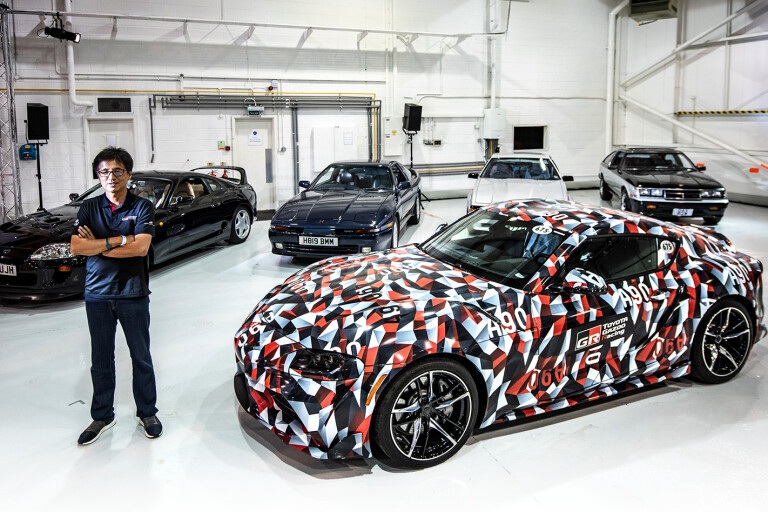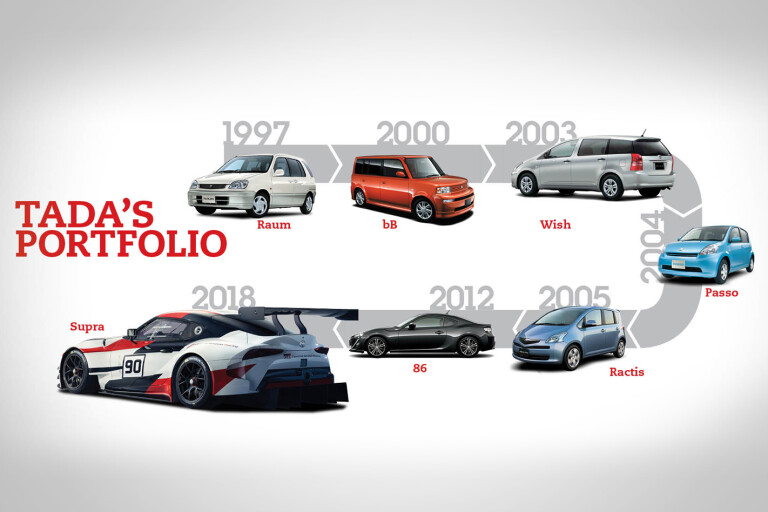
HERE was a time in the golden era of Japanese carmaking, between the mid-1980s and late-1990s, when Toyota showrooms were thick with tasty metal. Celicas, MR2s, Supras and Chasers sat alongside supercharged Crown Comforts, and forced induction was everywhere.
It was a good time to be a Toyota fan. However, once the Japanese economy went off the boil in the mid-1990s Toyota’s will to keep building fun cars evaporated with it. And so begun Toyota’s ‘whitegoods era’.
It was around this time that Tetsuya Tada, the man we best know as the chief engineer of the Toyota 86, cut his teeth as a vehicle project lead. As the automotive architect responsible for Toyota’s most engaging and dynamic car of this century, he’s a person worth knowing, and his latest project – the reincarnation of the mighty Supra – has the potential to spark a new level of enthusiasm for the Big T – and put an end to the whitegoods reputation. But Tada wasn’t always interested in making fast, driftable Toyotas. In his formative years, he wasn’t even interested In making cars at all.
“I was a rocker,” he says. “I was in a rock band at the end of high school; I started studying electronics because I liked electric guitars. I actually wanted to work for Yamaha, making instruments.”

But a gift from his parents of a Toyota Publica rekindled a love of cars that was first stoked by his rally-driving father, and Tada joined Toyota as a graduate software engineer instead. ABS and traction control were his bread and butter, and after stints in Japan’s frosty northern island Hokkaido and at Toyota’s sprawling Higashi Fuji research facility, he spent three years in Europe validating road cars and race cars.
However Tada’s early years as a chief engineer were decidedly less sexy than you might imagine.
“At the time, Toyota was trying to get the number-one sales spot in the world, and was walking away from making ‘inefficient’ sports cars that could not give us the number of sales,” says Tada. “We shifted to more [profitable] cars.”
From Tada’s point of view dull cars might have been making big money for Toyota at a time when the Japanese economy was contracting, but grocery-getters held little appeal to him. Senior management had different ideas, and in the mid-1990s Tada was lured to the world of product planning by Isao Tsuzuki – the chief engineer of the JZA80 Supra. Upon learning that the first car he would oversee would be a two-box MPV, his displeasure earned him a reprimand.
“As soon as I moved to that planning department, I asked Tsuzuki-san: ‘what car am I making?’ He said I’d be working on the Raum. It means ‘Room’ in German, but it’s a small car sold only in Japan, for carrying kids or elderly people. I was asked to do the plan for that car; I was really disappointed – it wasn’t a sports car! I complained to Tsuzuki-san, and he yelled at me. I was scolded by him: ‘Raum, Supra, have the same philosophy. If you don’t understand that, you’ll never make a sports car’. It took me more than 10 years until I understood what he meant.
“At that time I was in charge of minivans and of course the number of sales were going upwards and upwards, and the prospect of Toyota being ‘Number One’ was coming close. People were saying, ‘wow, Toyota is going really well’, however journalists would always say at the end of interviews: ‘Toyota’s cars are easy to use, they don’t break and are good value … but they’re not fun, they’re not interesting.’”
As his senpai, or mentor, Isao Tsuzuki taught Tada that building good cars was about much more than sharp handling or big power. Even boring cars would benefit from the same design philosophy that had made cars like Tsuzuki’s fourth-generation Supra fun.
“What he said about making sports cars is that it’s the same fundamentally as the Raum, or any car for that matter. Whatever the category, you have to think about the drivers, or the people who will be sitting in the seats.”
There was another harsh truth: sports cars couldn’t be loss-leaders in the world of Toyota. Every product had to pay its own way.
“Sports car development is about how you are going to develop the business case. Toyota isn’t a non-profit organisation – we don’t really make a lot of profit [making sports cars], but you really need to have at least some. With sports cars you can’t really sell a lot of them, and you use a lot of specific parts to get the performance. It’s a risky business, [which is why] a lot of board members don’t want to be involved in the sports car category.”
Tada’s experience in building compact vans for the budget-conscious proved instrumental to getting the 86 project across the line at the right price. Maximising parts-sharing and designing components that were cheap to produce were critical to keeping costs down.
“I learned that from making small cars. It was really useful, you have to have that kind of accumulated experience, otherwise you won’t be able to make production sports cars.”
Another crucial factor was Subaru’s role in the joint venture as the provider of the 86’s engine and platform. It comes as no surprise that Tada is teaming up with another manufacturer on his newest sports car project to help spread costs – the Supra will share its architecture and powertrains with BMW’s next-gen Z4.
But to dismiss it as a reskinned BMW is foolish. Tada proved with the 86 that an unconventional engineering approach can result in a car with vast driver appeal – even if said car is built largely on top of recycled suspension tech and borrowed engines. He remains fiercely proud of his decision to equip the 86 with low-friction tyres from the Prius for that reason.
He says to expect similar driver rewards with the new, fifth-generation ‘A90’ Supra.
“You’ll really need to drive it. It’s hard to express in words, but I’d like everyone to hold the steering wheel as soon as possible. On a circuit, or on the autobahn at over 200km/h, you’ll be able to enjoy it. Just drive it a few hundred kilometres and you’ll think, ‘Oh! It’s different!’ compared to conventional cars.”
Sadly Isao Tsuzuki, as the key influence on the man now responsible for injecting some much-needed joy into Japan’s most sober brand, won’t be able to critique the follow-up to his much-missed sports car and the product of his former understudy.
“Sports car making is very different from production cars, so I really wanted some advice from my senpai Tsuzuki-san. I went to see him, actually when I planned Hachiroku,” Tada says, using the Japanese name for his beloved 86.
“But before the launch of the Hachiroku, he died in an accident. If he was alive today he would be the first one I’d report to, and I’m sure he’d be very happy to see the Supra is continuing.”

TADA'S PORTFOLIO
Accusations that Toyota spent too long building boring cars hit close to home for Tetsuya Tada – after all, he spent much of his career creating them. As a chief engineer he spent over a decade developing a bevy of largely soulless boxes for Toyota to sell to the masses, until being mercifully relieved of that task in 2007 to oversee the creation of the 86.

COMMENTS